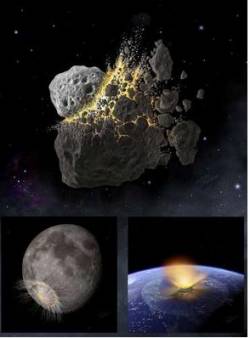Age of the lunar surface.
We can know the age of the lunar surface through its craters.
The craters of the Moon: The primary source of erosion on the Moon is interplanetary debris, in the form of small meteoroids that collide with the lunar suface. This material, much of it rocky or metallic in composition, is strewn throughout the solar system. It wanders around in interplanetary space, perhaps for billions of years, until it collides with some planet or moon. On Earth, most meteoroids burn up in the atmosphere, producing the streaks of light Known as meteors, or “shooting stars”. But the Monn, without atmosphere, has not protection against this onslaught. Large and small meteoroids just zoom lin and collide with the lunar surface, sometimes producing huge craters. Craters are still being formed today all across the lunar surface. More of 300.000 craters have been to observe in the Moon.

We will study the age of the lunar surface take into account:
We will study photos of lunar surface and the craters of these lunar surfaces. The more number of craters there are, and theirs diameters are bigger, the lunar surface is older. The more craters we measure, our study is better.
Also, we could use this metod to study the age of other surfaces, for example Mercury, because in Mercury there are a lot of craters.




